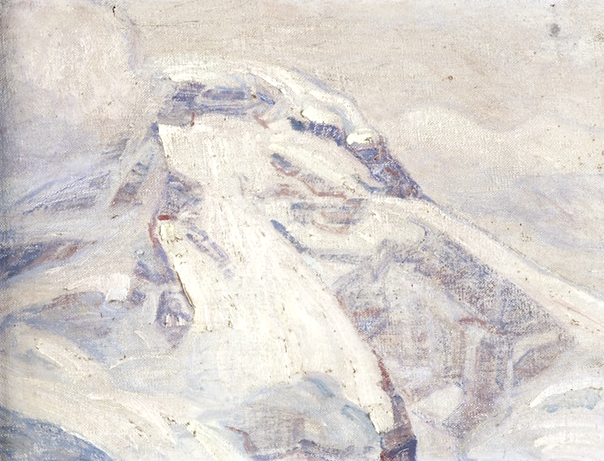In L’Eiger, le Mönch et la Jungfrau vus de Beatenberg aus, 1910, 1910, collection privée
Les montagnes
Le Mönch (4 107 m) (Le Moine) est une montagne des Alpes bernoises, en Suisse. Le Mönch se situe à la frontière entre les cantons du Valais et de Berne et fait partie d'une crête montagneuse entre la Jungfrau et le Jungfraujoch à l'ouest et l'Eiger à l'est. Le versant nord du Mönch forme un mur en escalier au-dessus de la vallée de Lauterbrunnen. Le tunnel ferroviaire de la Jungfrau passe juste sous le sommet, à une altitude d'environ 3 300 mètres (10 830 pieds). Le sommet a été escaladé pour la première fois il y a 159 ans en 1857 le 15 août, par Christian Almer, Christian Kaufmann, Ulrich Kaufmann et Sigismund Porges.
L'Eiger (3 970 m) est situé dans les Alpes bernoises, surplombant Grindelwald et Lauterbrunnen dans l'Oberland bernois, juste au nord du bassin versant principal et à la frontière avec le Valais. C'est le sommet le plus à l'est d'une crête qui s'étend à travers le Mönch jusqu'à la Jungfrau à (4 158 m-13 642 ft), constituant l'un des sites les plus emblématiques des Alpes suisses. La caractéristique la plus remarquable de l'Eiger est sa face nord de roche et de glace de 1 800 mètres de haut - 5 900 pieds, appelée Eigerwand ou Nordwand, qui est la plus grande face nord des Alpes. Cette immense face domine la station de Kleine Scheidegg à sa base, sur le col homonyme reliant les deux vallées.
La première ascension de l'Eiger a été réalisée par les guides suisses Christian Almer et Peter Bohren et l'Irlandais Charles Barrington, qui ont escaladé le flanc ouest le 11 août 1858.
Le peintre
Ferdinand Hodler était l'un des peintres suisses les plus connus du XIXe siècle. Ses premières œuvres étaient des portraits, des paysages et des peintures de genre dans un style réaliste. Plus tard, il adopta une forme personnelle de symbolisme qu'il appela Parallélisme.
Au cours de la dernière décennie du 19e siècle, son travail a évolué pour combiner les influences de plusieurs genres, dont le symbolisme et l'Art nouveau. En 1890, il achève Night, une œuvre qui marque le tournant de Hodler vers l'imagerie symboliste. Il représente plusieurs gisants, tous détendus dans le sommeil, à l'exception d'un homme agité qui est menacé par une silhouette enveloppée de noir, que Hodler a conçue comme un symbole de mort. Hodler a développé un style qu'il a appelé «parallélisme» qui mettait l'accent sur la symétrie et le rythme qui, selon lui, formaient la base de la société humaine. Dans des peintures telles que The Chosen One , des groupements de personnages sont disposés symétriquement dans des poses évoquant un rituel ou une danse.
Hodler a peint un certain nombre de peintures historiques à grande échelle, souvent avec des thèmes patriotiques. En 1897, il accepte une commande pour peindre une série de grandes fresques pour la salle d'armes du Schweizerisches Landesmuseum de Zurich. Les compositions qu'il a proposées, y compris La bataille de Marignan qui dépeignait une bataille perdue par les Suisses, étaient controversées pour leur imagerie et leur style, et Hodler n'a été autorisé à exécuter les fresques qu'en 1900.
L'œuvre de Hodler dans sa phase finale prend un aspect expressionniste avec des figures fortement colorées et géométriques. Les paysages sont réduits à l'essentiel, constitués parfois d'un coin de terre déchiqueté entre l'eau et le ciel.
2023 - Wandering Vertexes ....
Errant au-dessus des Sommets Silencieux...
Un blog de Francis Rousseau









-%20the%20MAiden%20of%20the%20mist%20over%20the%20sea%201908%20.png)